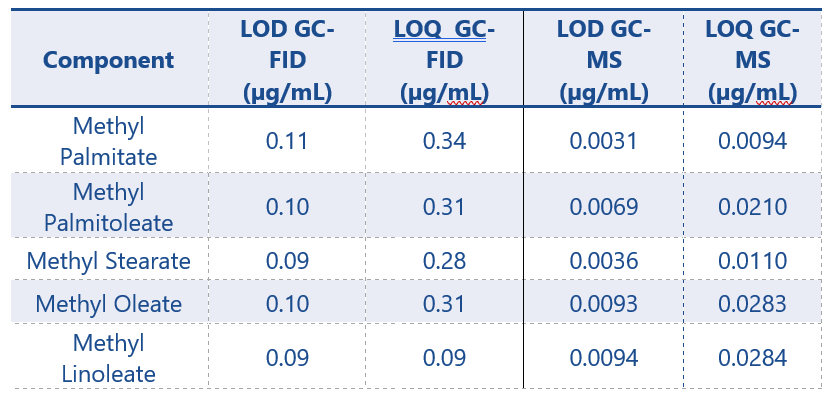Comparison of FAME Analysis in Olive Oil by GC-FID and GC-MS
Why is FAME analysis of olive oil important?
The determination of Fatty Acid Methyl Esters (FAME) is a commonly performed analysis, to determine the quality of extra virgin olive oil (EVOO). Natural EVOO is made by pressing or centrifuging olives, without exposing the olives to any chemical processing. A way of producing cheaper olive oil is to mix them with cheaper oils, such as sunflower oil and refined olive oils. This mixing with refined olive oils results in a divergent fatty acid content in the end product.
The composition of FAME compounds in EVOO provides substantial data regarding the quality and origin of the olive oil, making this analysis critical for quality control.
The quantification and qualification of FAME in EVOO can be performed by both gas chromatography – Flame Ionization Detection (GC-FID) and GC-Mass Spectrometry (GC-MS).
Separation of FAME compounds
FAME compounds can be very challenging to separate from one another especially for the cis and trans isomers. The SCION FAME application specific column provides excellent specificity as shown in Figures 1 and 2.
Figure 1 TIC chromatogram of the FAME-standard (GC-MS analysis)
Figure 2 Chromatogram of the FAME-standard (GC-FID analysis)
Why use GC-MS for the quantification and qualification of FAME in EVOO?
GC-MS has the capability of identifying components as well as unknowns – through the NIST library search tool which is embedded into the MS work station software. Mass spectrometry also benefits from being able to detect at lower limits than GC-FID analysis.
Why use GC-FID for the quantification and qualification of FAME in EVOO?
GC-FID analysis has the benefit of being much cheaper than mass spectrometry – while still meeting regulatory requirements. However identifying unknowns and performing analyte confirmation is trickier than with GC-MS, which could lead to longer downtimes to investigate contamination and unknowns whilst also increasing the chance of a false positive result.
Should I use GC-MS or GC-FID for my application?
GC-FID is suitable for most applications involving FAME – however, if you require an LOQ which is very low then GC-MS is best for your analysis. Also, if regulations change and lower detection limits are required then GC-MS serves as a good alternative to GC-FID analysis. Table 1 shows example LOD’s/LOQ’s for FAME compounds between GC-FID and GC-MS.
Table 1 Comparison of FAME LOD/LOQ results
GC-MS also has the added advantage of being able to easily confirm analyte identity and to identify any unknowns or contaminants present in your samples using the powerful NIST library search tool built into SCION MSWS software.
GC-MS Enquiry Form



